Modulation Classification of Underwater Communication Signals Based on Channel Estimation
Abstract
1. Introduction
- We consider the classification of underwater modulated signals and channel estimation together.
- By estimating the acoustic channel parameters within a specific range, we can restore communication signals distorted by underwater transmission. This reduces the instances where the classical classification algorithm is not applicable due to the influence of the underwater acoustic environment on modulated signal classification, thereby enhancing the algorithm’s universality in underwater environments.
- The proposed method was validated through both simulation and real-world experiments, which confirmed the effectiveness of the approach. The results demonstrate that, when applying the classical classification algorithm, the recognition performance of modulated signals after restoration is significantly enhanced. Under ideal conditions, certain classifiers can achieve performance levels that closely approximate those observed without underwater channels, thus demonstrating the method’s ability to mitigate channel effects.
2. Modulation Recognition Algorithm Based on Channel Parameter Inversion
2.1. Model-Based Underwater Acoustic Channel Estimation
2.2. Modulation Identification Based on Channel Inversion
3. Experiments and Results
3.1. Dataset Preparation
3.2. Modulation Recognition Experiment
3.3. Five-Element Acoustic Dataset Experiment
4. Discussion
5. Conclusions
Author Contributions
Funding
Institutional Review Board Statement
Informed Consent Statement
Data Availability Statement
Conflicts of Interest
References
- Wang, J.; Shen, T.S.; Zhao, D.X.; Zhang, F.T. Flow Sensing-Based Underwater Target Detection Using Distributed Mobile Sensors. In Proceedings of the 2022 IEEE 61st Conference on Decision and Control (CDC), Cancun, Mexico, 6–9 December 2022; Volume 12, pp. 2681–2687. [Google Scholar]
- Yin, J.W. Underwater Acoustic Communication Principles and Signal Processing Technology; National Defense Industry Press: Arlington, TX, USA, 2011. [Google Scholar]
- Weaver, C.S.; Cole, C.A.; Krumland, R.B. The Automatic Classification of Modulation Types by Pattern Recognition; Stanford University: Stanford, CA, USA, 1969. [Google Scholar]
- Gardner, W.A. The spectral correlation theory of cyclostationary time-series. Signal Process. 1986, 11, 13–36. [Google Scholar] [CrossRef]
- Gardner, W.A. Spectral correlation of modulated signals: Part I—Analog modulation. IEEE Trans. Commun. 1987, 35, 584–594. [Google Scholar] [CrossRef]
- Gardner, W.A.; Brown, W.A.I.; Chen, C.K. Spectral correlation of modulated signals: Part II—Digital Modulation. IEEE Trans. Commun. 1987, 35, 595–601. [Google Scholar] [CrossRef]
- Gardner, W.A. A unifying view of second-order measures of quality for signal classification. IEEE Trans. Commun. 1980, 28, 807–816. [Google Scholar] [CrossRef]
- Whelchel, J.E.; McNeill, D.L.; Hughes, R.D. Signal Understanding: An Artificial Intelligence Approach to Modulation Classification. In Proceedings of the IEEE International Workshop on Tools for Artificial Intelligence, Fairfax, VA, USA, 23–25 October 1989; pp. 231–236. [Google Scholar]
- Soliman, S.S.; Hsue, S.Z. Signal Classification Using Statistical Moments. IEEE Trans. Commun. 1992, 40, 908–916. [Google Scholar] [CrossRef]
- Ghani, N.; Lamontagne, R. Neural networks applied to the classification of spectral features for automatic modulation recognition. In Proceedings of the MILCOM’93-IEEE Military Communications Conference, Boston, MA, USA, 11–14 October 1993; IEEE: New York, NY, USA, 1993; Volume 1, pp. 111–115. [Google Scholar]
- Azzouz, E.; Nandi, A.K. Automatic Modulation Recognition of Communication Signals; Kluwer Academic Publishers: New York, NY, USA, 1996. [Google Scholar]
- Azzouz, E.E.; Nandi, A.K. Modulation recognition using artificial neural networks. Signal Process. 1997, 56, 165–175. [Google Scholar]
- Nandi, A.K.; Azzouz, E.E. Algorithms for automatic Modulation recognition of communication signals. IEEE Trans. Commun. 1998, 46, 431–436. [Google Scholar] [CrossRef]
- Le Martret, C.J.; Boiteau, D. Modulation classification by means of different orders statistical moments. In Proceedings of the MILCOM 97 MILCOM 97 Proceedings, Monterey, CA, USA, 3–5 November 1997; IEEE: New York, NY, USA, 1997; Volume 3, pp. 1387–1391. [Google Scholar]
- Donoho, D.L.; Huo, X. Large-sample modulation classification using Hellinger representation. In Proceedings of the First IEEE Signal Processing Workshop on Signal Processing Advances in Wireless Communications, Paris, France, 16–18 April 1997; IEEE: New York, NY, USA, 1997; pp. 133–136. [Google Scholar]
- Swami, A.; Sadler, B.M. Hierarchical digital modulation classification using cumulants. IEEE Trans. Commun. 2000, 48, 416–429. [Google Scholar] [CrossRef]
- Ho, K.C.; Prokopiw, W.; Chan, Y. Modulation identification of digital signals by the wavelet transform. IEEE Proc.-Radar Sonar Navig. 2000, 147, 169–176. [Google Scholar] [CrossRef]
- Dobre, O.A.; Bar-Ness, Y.; Su, W. Higher-order cyclic cumulants for high order modulation classification. In Proceedings of the IEEE Military Communications Conference. MILCOM 2003, Boston, MA, USA, 13–16 October 2003; IEEE: New York, NY, USA, 2003; Volume 1, pp. 112–117. [Google Scholar]
- Fehske, A.; Gaeddert, J.; Reed, J.H. A new approach to signal classification using spectral correlation and neural networks. In Proceedings of the First IEEE International Symposium on New Frontiers in Dynamic Spectrum Access Networks, 2005. DySPAN 2005, Baltimore, MD, USA, 8–11 November 2005; IEEE: New York, NY, USA, 2005; pp. 144–150. [Google Scholar]
- Headley, W.C.; Reed, J.D.; da Silva, C.R. Distributed cyclic spectrum feature-based modulation classification. In Proceedings of the 2008 IEEE Wireless Communications and Networking Conference, Las Vegas, NV, USA, 31 March–3 April 2008; IEEE: New York, NY, USA, 2008; pp. 1200–1204. [Google Scholar]
- Like, E.; Chakravarthy, V.; Ratazzi, P.; Wu, Z. Signal classification in fading channels using cyclic spectral analysis. EURASIP J. Wirel. Commun. Netw. 2009, 2009, 879812. [Google Scholar] [CrossRef]
- Punchihewa, A.; Zhang, Q.; Dobre, O.A.; Spooner, C.; Rajan, S.; Inkol, R. On the Cyclostationarity of OFDM and Single Carrier Linearly Digitally Modulated Signals in Time Dispersive Channels: Theoretical Developments and Application. IEEE Trans. Wirel. Commun. 2010, 9, 2588–2599. [Google Scholar] [CrossRef]
- O’Shea, T.J.; Corgan, J.; Clancy, T.C. Convolutional radio modulation recognition networks. In Proceedings of the Engineering Applications of Neural Networks: 17th International Conference, EANN 2016, Aberdeen, UK, 2–5 September 2016; Proceedings 17. Springer International Publishing: New York, NY, USA, 2016; pp. 213–226. [Google Scholar]
- Zhang, F.; Luo, C.; Xu, J.; Luo, Y. An efficient deep learning model for automatic modulation recognition based on parameter estimation and transformation. IEEE Commun. Lett. 2021, 25, 3287–3290. [Google Scholar] [CrossRef]
- Zhang, F.; Luo, C.; Xu, J.; Luo, Y.; Zheng, F.C. Deep learning based automatic modulation recognition: Models, datasets, and challenges. Digit. Signal Process. 2022, 129, 103650. [Google Scholar] [CrossRef]
- Keller, J.B. Rays, waves and asymptotics. Bull. Amer. Math. Soc. 1978, 84, 727–750. [Google Scholar] [CrossRef]
- Pekeris, C.L. Theory of Propagation of Explosive Sound in Shallow Water; Geological Society of America: Boulder, CO, USA, 1948; p. 27. [Google Scholar]
- Hardin, R.H.; Tappert, F.D. Applications of the Split-Step Fourier Method to the Numerical Solution of Nonlinear and Variable Coefficient Wave Equations. SIAM Rev. 1973, 15, 423. [Google Scholar]
- Jensen, F.B.; Kuperman, W.A.; Porter, M.B.; Schmidt, H. Computational Ocean Acoustics; Springer: New York, NY, USA, 2011; pp. 457–527. [Google Scholar]
- Nello, C.; John, S.T. An Introduction to Support Vector Machines and Other Kernel-Based Learning Methods; United Kingdom at the University Press: Cambridge, UK, 2000. [Google Scholar]
- Chen, T.; Guestrin, C. Xgboost: A scalable tree boosting system. In Proceedings of the 22nd Acm Sigkdd International Conference on Knowledge Discovery and Data Mining, San Francisco, CA, USA, 13–17 August 2016; pp. 785–794. [Google Scholar]
- O’Shea, T.J.; West, N. Radio machine learning dataset generation with gnu radio. In Proceedings of the GNU Radio Conference, Boulder, CO, USA, 12–16 September 2016; Volume 1. [Google Scholar]
- Perrine, K.A.; Nieman, K.F.; Henderson, T.L.; Lent, K.H.; Brudner, T.J.; Evans, B.L. University of Texas Applied Research Laboratory Nov. In Five-Element Acoustic Underwater Dataset; Technical Report; University of Texas: Austin, TX, USA, 2009. [Google Scholar]
- Perrine, K.A.; Nieman, K.F.; Henderson, T.L.; Lent, K.H.; Brudner, T.J.; Evans, B.L. Doppler estimation and correction for shallow underwater acoustic communications. In Proceedings of the 2010 Conference Record of the Forty Fourth Asilomar Conference on Signals, Systems and Computers, Pacific Grove, CA, USA, 7–10 November 2010; IEEE: New York, NY, USA, 2010; pp. 746–750. [Google Scholar]
- Spurek, P.; Tabor, J.; Rola, P.; Ociepka, M. ICA based on asymmetry. Pattern Recognit. 2017, 67, 230–244. [Google Scholar] [CrossRef]
- Ardizzon, F.; Casari, P.; Tomasin, S. A RNN-based approach to physical layer authentication in underwater acoustic networks with mobile devices. Comput. Netw. 2024, 243, 110311. [Google Scholar] [CrossRef]

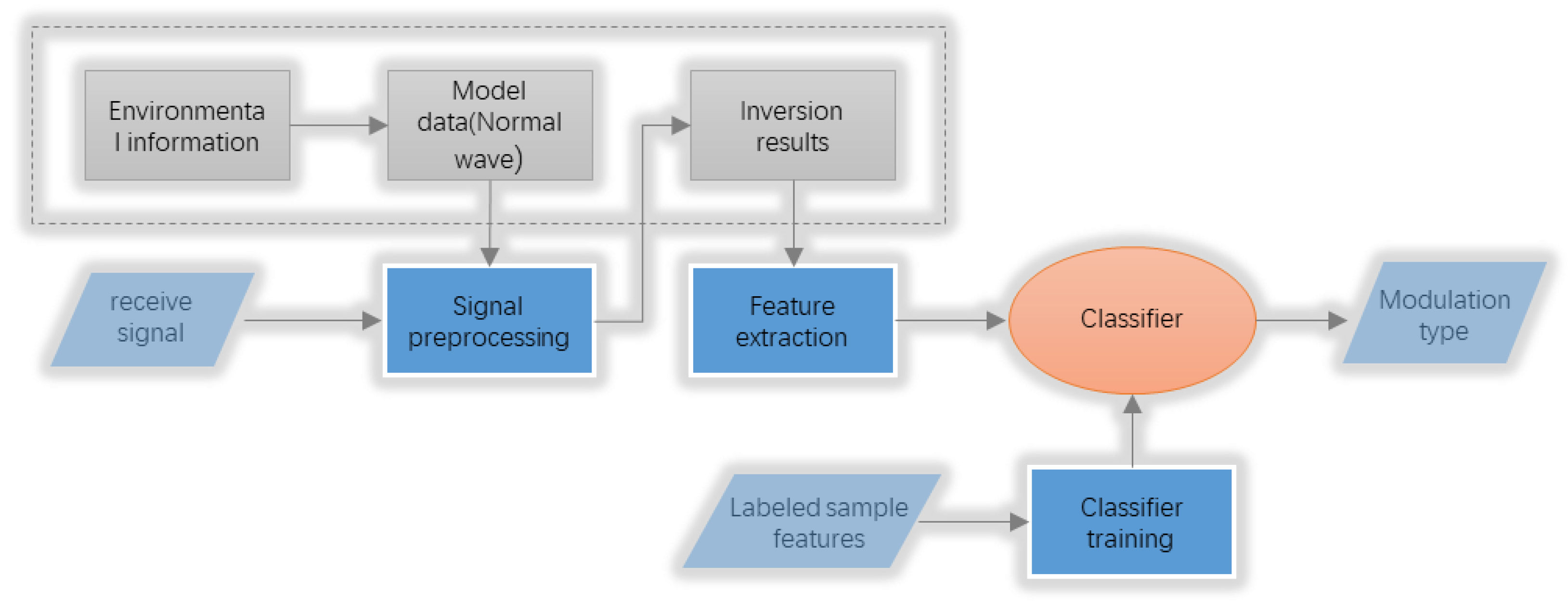
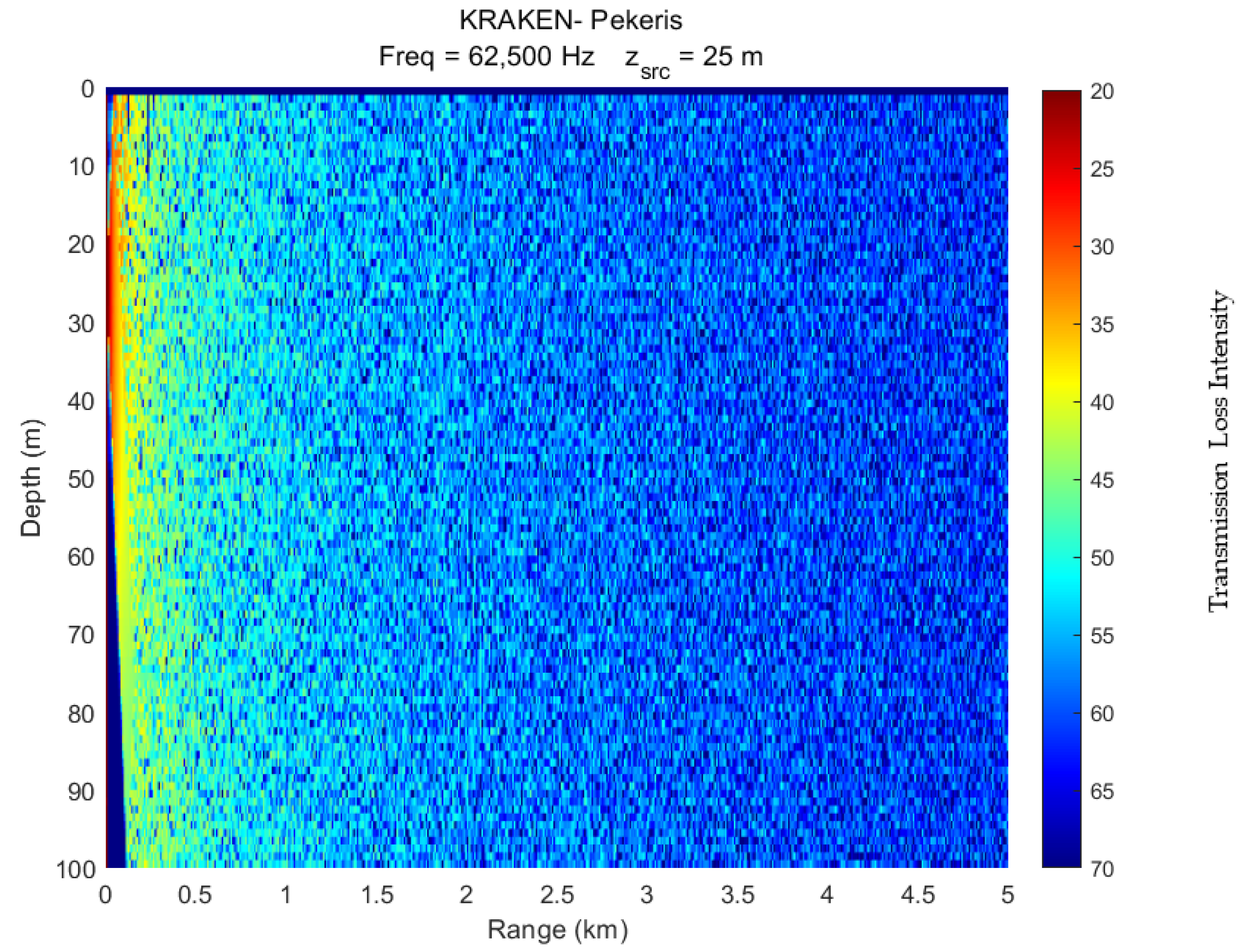
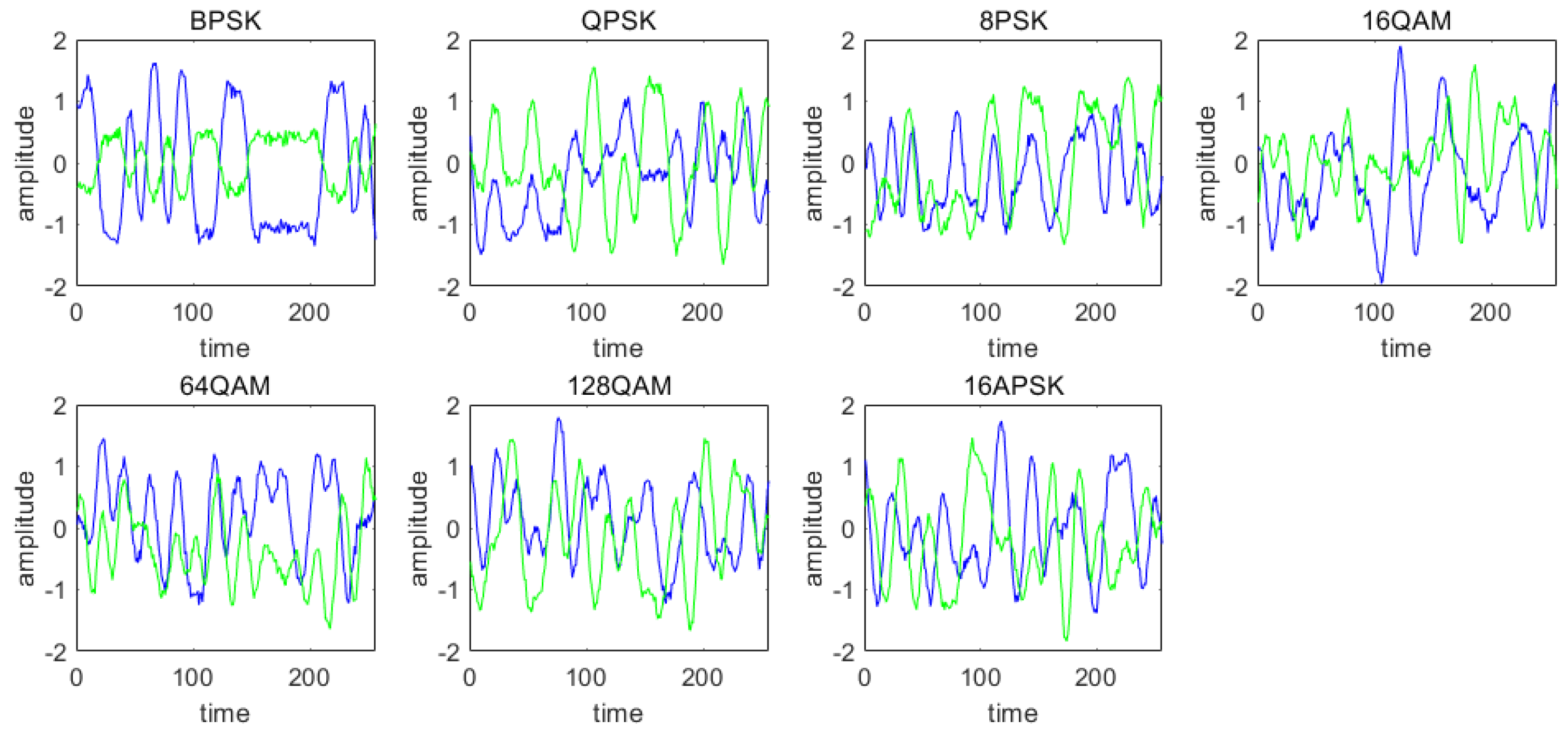
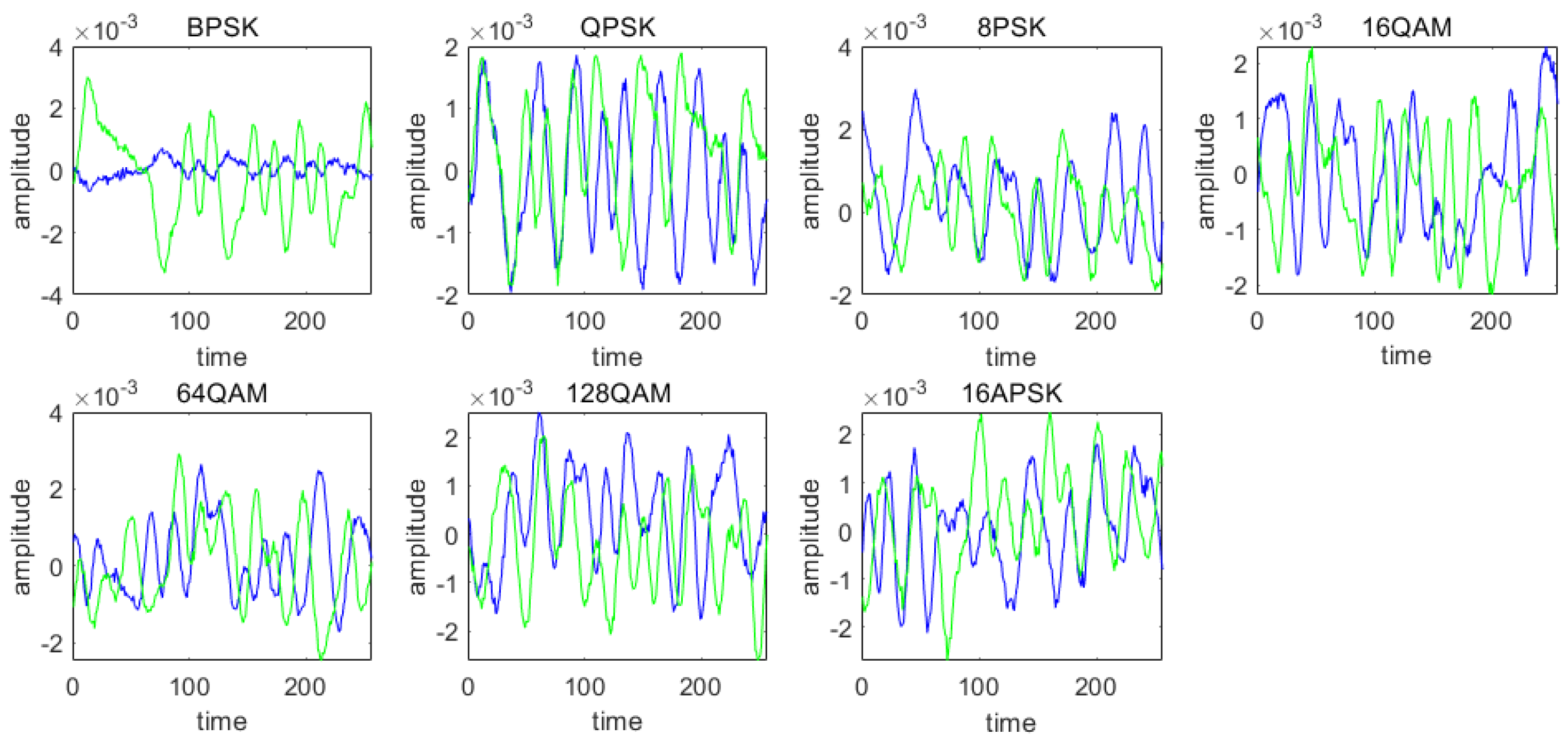
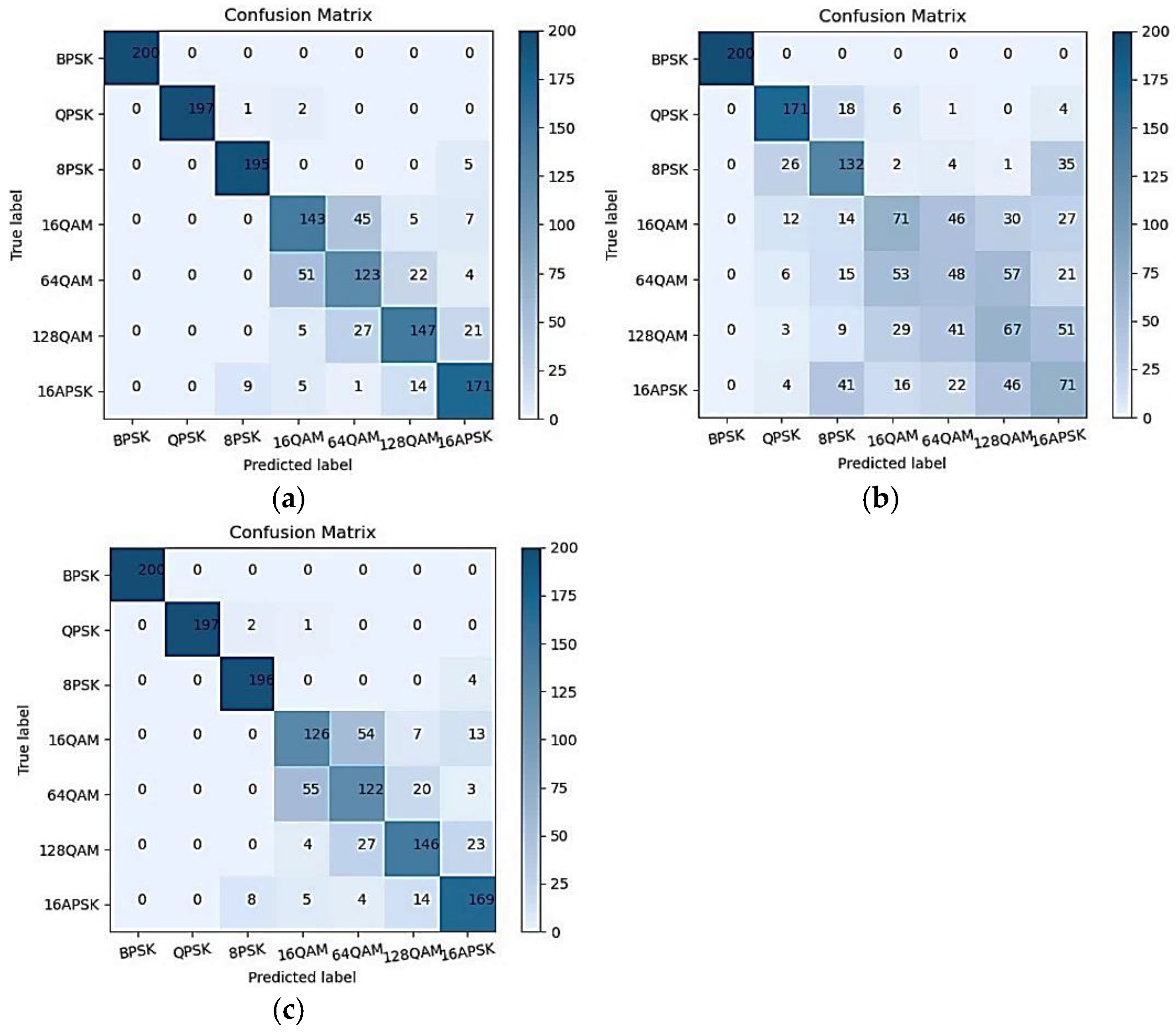
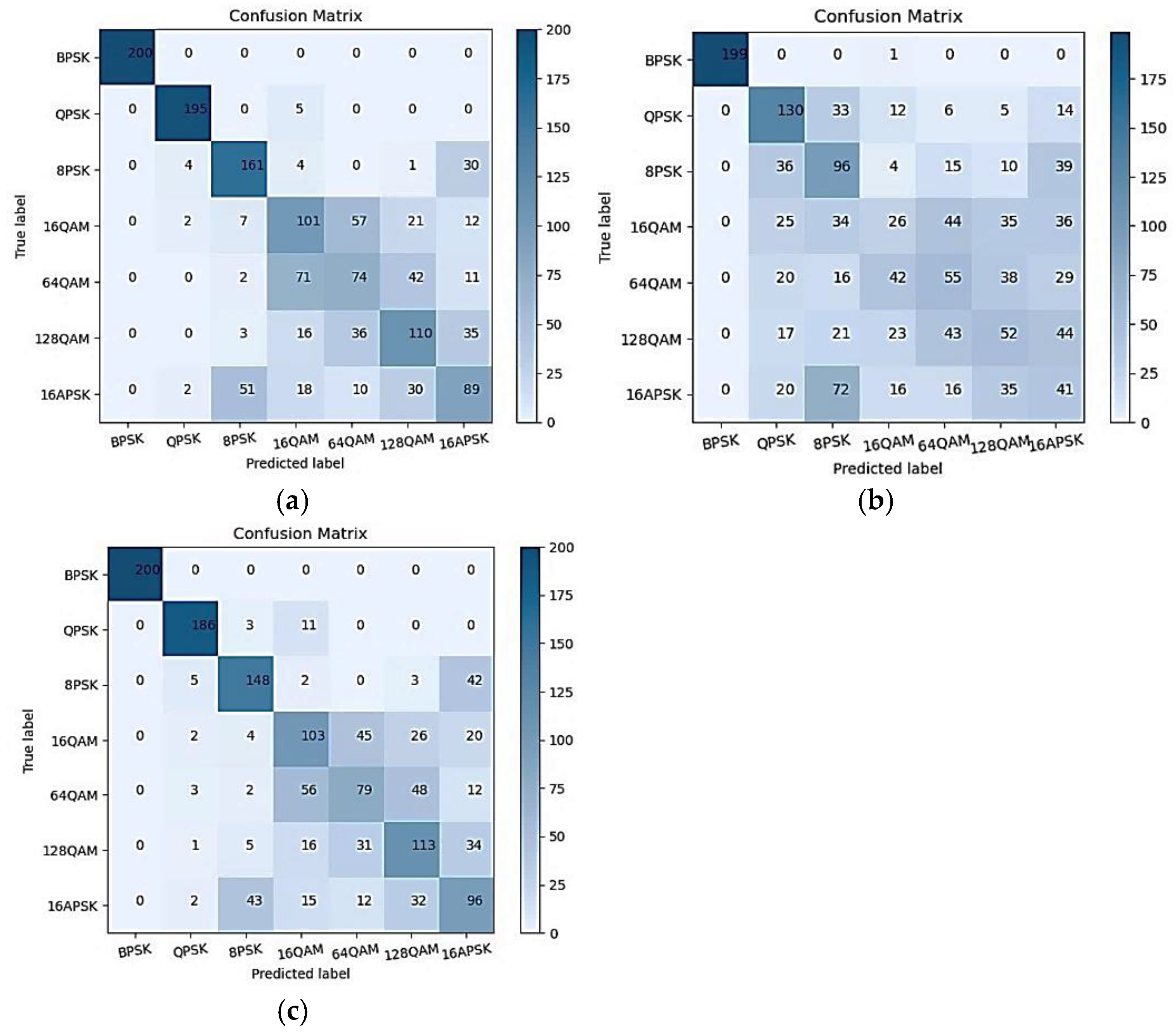
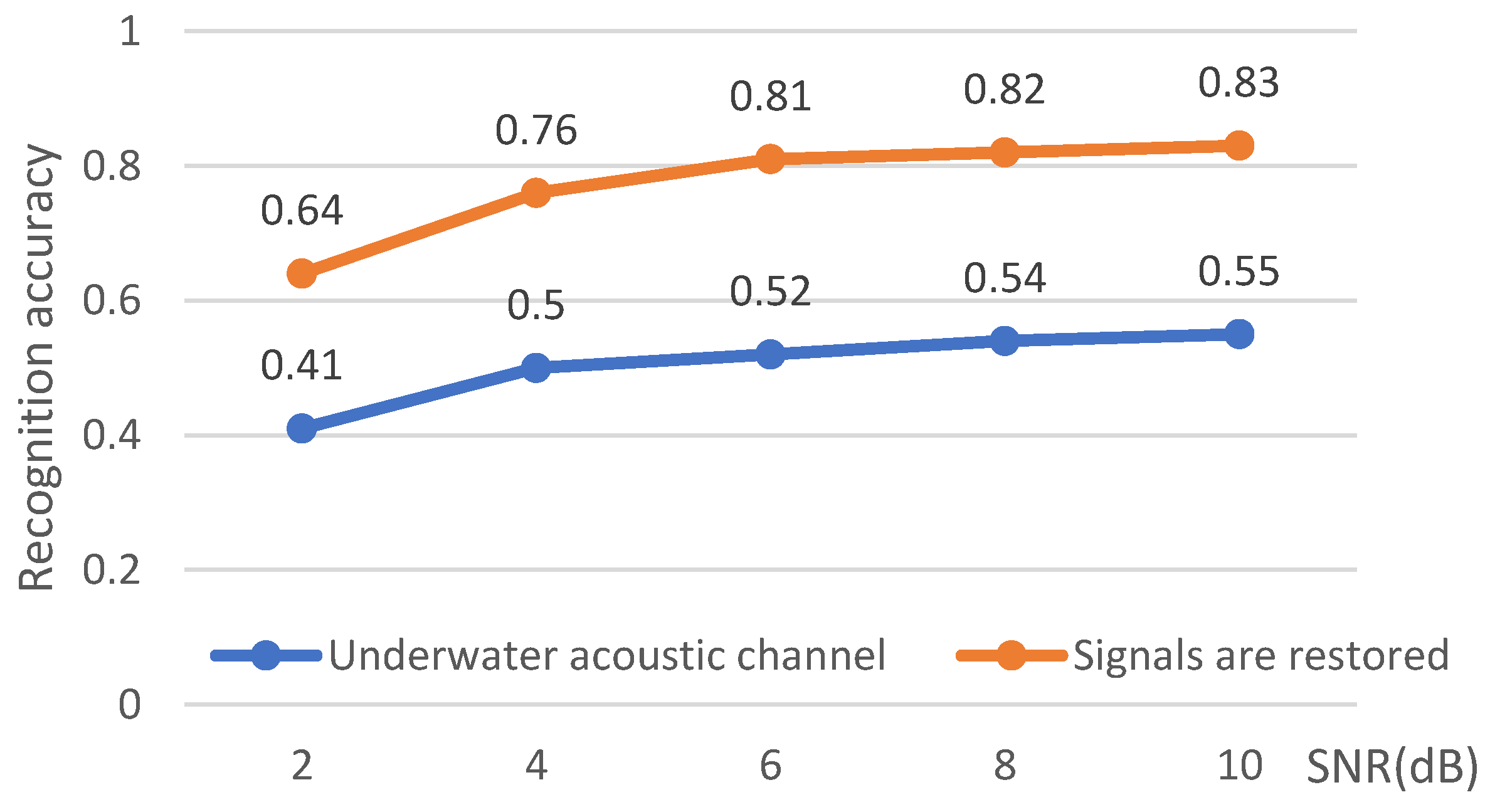
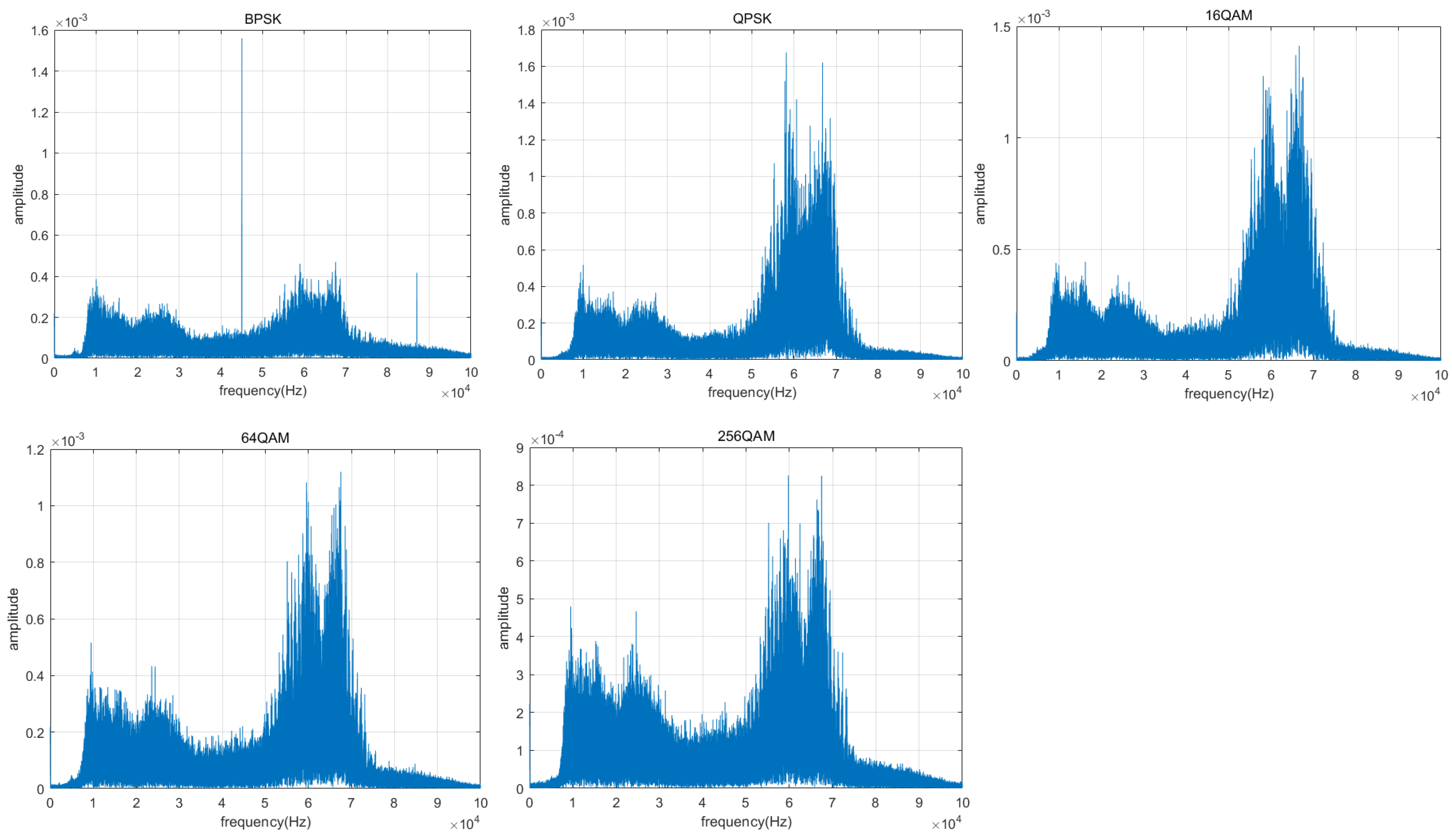
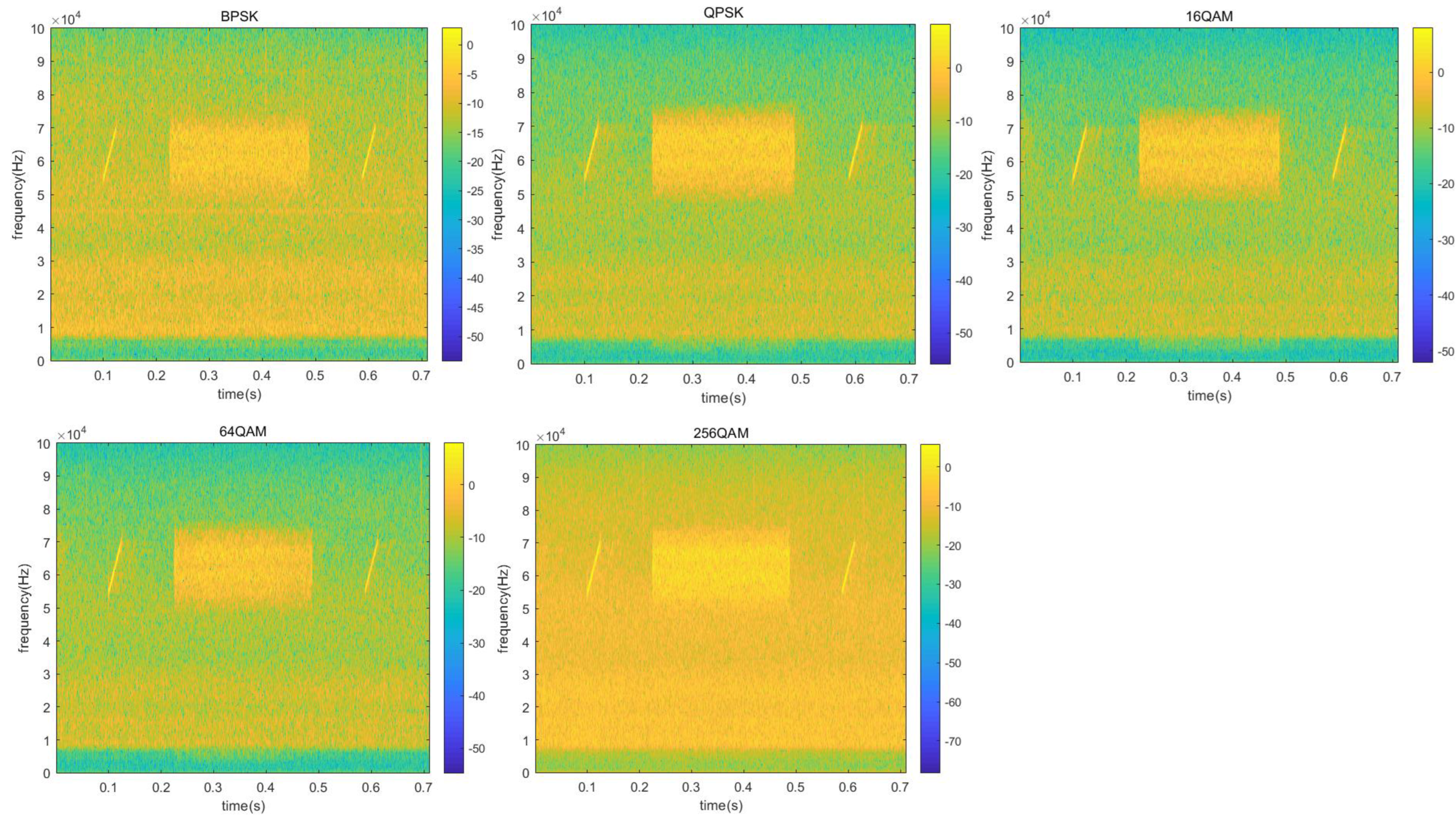
| Classifiers | AWGN Channel | Underwater Acoustic Channel | Restored Signals | Time Consumed |
|---|---|---|---|---|
| Random Forest | 82.35% | 51.71% | 80.35% | 37.94 ms |
| Decision Tree | 79.64% | 48.21% | 77.14% | 46.79 ms |
| KNN | 80.57% | 50.5% | 72.92% | 31.25 ms |
| GBDT | 84.14% | 54.28% | 82.5% | 8720.94 ms |
| Logistic Regression | 82.5% | 54.21% | 78.57% | 169.21 ms |
| LDA | 81.71% | 53.71% | 78.85% | 10.11 ms |
| SVM | 75.57% | 16.85% | 71.21% | 2641.05 ms |
| Adaptive Boosting | 67.71% | 28.49% | 51.57% | 222.78 ms |
| Gaussian Naive Bayes | 79.07% | 47.0% | 77.5% | 2.23 ms |
| Extreme Gradient Boosting | 82.21% | 53.0% | 81.57% | 1074.71 ms |
| Descriptor | LFM BW (kHz) | LFM dur. (ms) | LFM to Data (ms) | Modl. | Symbol Rate (ksym/s) | Symbols Transmitted | Pulse Shape |
|---|---|---|---|---|---|---|---|
| SRRC fast BPSK w/pilots | 15.625 | 25 | 125.032 | BPSK | 15.625 | 4096 | SRRC |
| SRRC fast QPSK | 15.625 | 25 | 125.032 | QPSK | 15.625 | 4096 | SRRC |
| SRRC fast 16QAM | 15.625 | 25 | 125.032 | 16QAM | 15.625 | 4096 | SRRC |
| SRRC fast 64QAM | 15.625 | 25 | 125.032 | 64QAM | 15.625 | 4096 | SRRC |
| SRRC fast 256QAM | 15.625 | 25 | 125.032 | 256QAM | 15.625 | 4096 | SRRC |
| Classifiers | Underwater Acoustic Channel | Restored Signals | Time Consumed |
|---|---|---|---|
| Random Forest | 53.33% | 80.0% | 15.62 ms |
| Decision Tree | 40.0% | 86.66% | 0.0 ms |
| GBDT | 46.66% | 86.66% | 269.73 ms |
| Gaussian Naive Bayes | 20.0% | 53.33% | 0.0 ms |
| Extreme Gradient Boosting | 40.0% | 93.33% | 61.31 ms |
Disclaimer/Publisher’s Note: The statements, opinions and data contained in all publications are solely those of the individual author(s) and contributor(s) and not of MDPI and/or the editor(s). MDPI and/or the editor(s) disclaim responsibility for any injury to people or property resulting from any ideas, methods, instructions or products referred to in the content. |
© 2024 by the authors. Licensee MDPI, Basel, Switzerland. This article is an open access article distributed under the terms and conditions of the Creative Commons Attribution (CC BY) license (https://creativecommons.org/licenses/by/4.0/).
Share and Cite
Yang, X.; Wang, Z.; Shen, T.; Zhao, D. Modulation Classification of Underwater Communication Signals Based on Channel Estimation. J. Mar. Sci. Eng. 2024, 12, 1877. https://doi.org/10.3390/jmse12101877
Yang X, Wang Z, Shen T, Zhao D. Modulation Classification of Underwater Communication Signals Based on Channel Estimation. Journal of Marine Science and Engineering. 2024; 12(10):1877. https://doi.org/10.3390/jmse12101877
Chicago/Turabian StyleYang, Xiaodan, Zulin Wang, Tongsheng Shen, and Dexin Zhao. 2024. "Modulation Classification of Underwater Communication Signals Based on Channel Estimation" Journal of Marine Science and Engineering 12, no. 10: 1877. https://doi.org/10.3390/jmse12101877
APA StyleYang, X., Wang, Z., Shen, T., & Zhao, D. (2024). Modulation Classification of Underwater Communication Signals Based on Channel Estimation. Journal of Marine Science and Engineering, 12(10), 1877. https://doi.org/10.3390/jmse12101877






